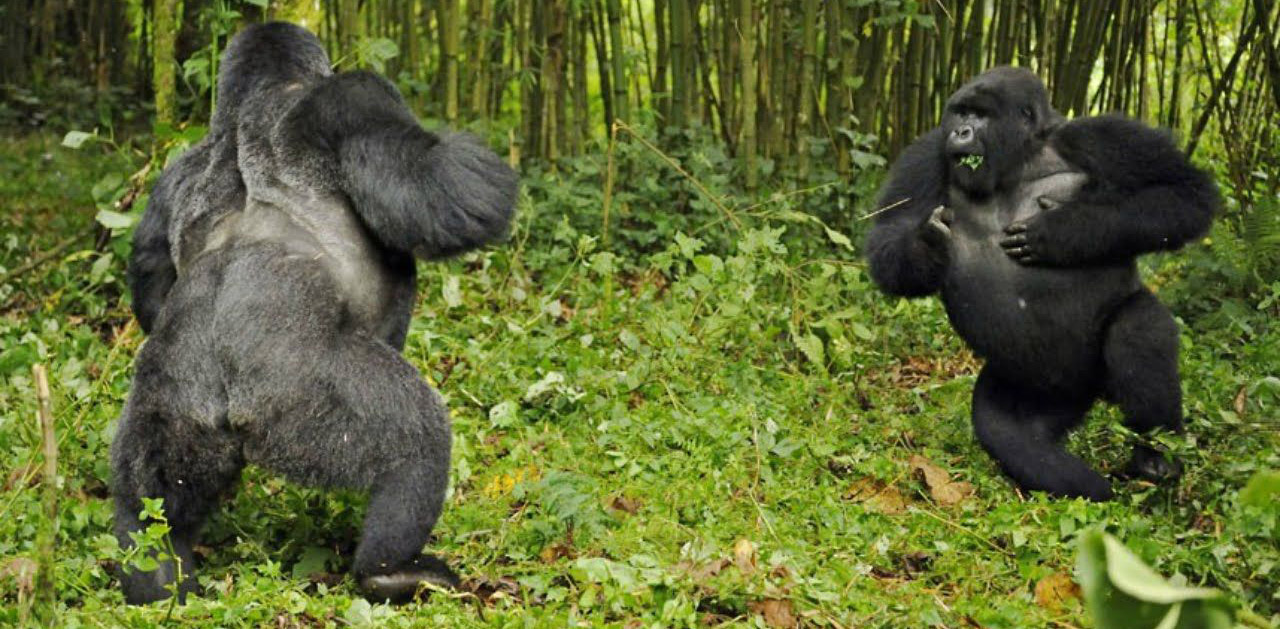
Gorilla adaptations in the tropical rain forest
Gorilla adaptations in the tropical rain forest.
Gorilla adaptations in the tropical rain forest :Mountain gorillas adapt to their surroundings in different ways, which are rendered possible by their bodies and the places they live. Mountain gorillas are a rare species of ape. They live in the vast and dense tropical wilderness of the Virunga Massifs, which has Mgahinga Gorilla National Park, Virunga National Park, and Volcanoes National Park, as well as Uganda’s Bwindi Impenetrable National Park. These national parks are the only ones in the entire world that reside in the endangered mountain gorillas that are over 1063 only and these can be witnessed during gorilla trekking safari. Mountain gorillas still live in the thick tropical rainforests of the Virunga Massif and Bwindi, which are up to 4000 m or more above sea level.
Mountain gorillas were almost extinct by the end of the 19th century, but primatologists like Dian Fossey and gorilla conservationists helped them slowly come back. By 2018, they were no longer listed as severely endangered but as endangered. Mountain gorillas live in families or groups, which are led by a strong male called a “silverback.” An ape family or group can have anywhere from 5 to 30 members.
Here are a few ways that mountain gorillas have learned to live in their tropical rain forests.
Mountain gorillas keep warm in the high-altitude jungles, where it is very cold, by having long, thick fur all over their bodies. Because they have long hair, they are less likely to get cold-related diseases like the flu, cough, or asthma. Their long, thick fur also keeps them safe from the many insects that live in the jungle.

Mountain gorillas mostly eat forest plants, which are plentiful in the jungles they live in. This has allowed them to adapt to their surroundings by eating only the plants that are there. They don’t have to go to other places to find food or chase after animals. Mountain gorillas eat like kings and queens because there is so much food in the tropical rainforests of the Virunga Massifs and Bwindi Impenetrable National Park. They don’t even have to move so far to get what they need to eat.
Mountain gorillas have flat teeth that help them chew and grind the cellulose in the plants they eat. This is another way they adapt to their natural habitat. They can chew the roots and shoots of plants with their teeth, and the bacteria in their guts help break the food down into a form that is easier to digest.
Mountain gorillas use their arms to move on the ground and to choose what to eat. This is one way they have learned to live in their surroundings. They have big, strong arms that help them move on all fours, like when they’re holding their babies on their backs, or when they’re picking food by standing up and stretching to reach the leaves they want.
They have fingers on their hands that they use to break shots, leaves, and fruits that they want to eat. This is easier for them to do because their thumbs are bigger than their other fingers. This makes it easier for them to press on the fruit and break it open faster.
When there is a danger, like a fight, a silverback uses his hands to fight off the enemy while they scream and hoot. The silverback also uses its hands to thump its chest as a sign of dominance. This helps them adapt to their surroundings, so they can stay alive.
Mountain gorillas adapt to their surroundings by being secretive, especially when they are in danger, because they would rather leave than get involved. Mountain gorillas, like all wild animals, can sense trouble from a long way away. They will try to avoid a fight as much as possible, so they can sneak away when they feel trouble.
Mountain gorillas have also adjusted to socialization amongst themselves and to humans as well (those that are habituated and can be visited on a gorilla trekking safari experience) with the help of their body language and over 25 different vocalizations that they use. They have feelings, just like people do, and they can tell their family members and people about them. For example, when mountain gorillas are stressed out by humans, they can get loud and show signs of anxiety, which makes people leave them alone. This has helped them get used to their surroundings.
Mountain gorillas also adapt to their tropical rain forest by living in groups led by a dominant silverback. This silverback tells the other members what to eat and where to sleep every day. This makes them feel like they fit and gives them a sense of direction. It also brings order to a family.
Some of the ways mountain gorillas adapt to their surroundings are listed above. A gorilla trekking tour lets you see mountain gorillas in the rainforests where they live. There are habituated gorilla families that allow human interaction and presence and it is these that tourists can visit all year long though the dry season of June-Augusts and December-February are the most advised. To see them, you’ll need a gorilla permit. Contact a reputable tour guide company to help you get one and plan the best gorilla trekking in Africa safari.







